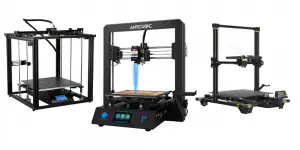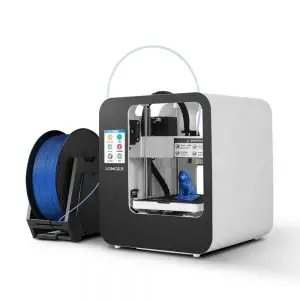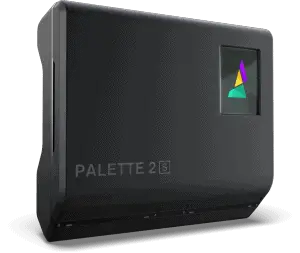Whether you’re looking for the No products found. or its extended version, it’s useful to know that Tiertime takes a simplistic approach to its line of 3D printers. It offers a series of upgrades and add-ons that both enhance and customize the machine to your liking. Let’s get into the tech specs:
Tiertime Cetus Technical Specs
| Build Volume (Standard version): | 180 mm x 180 mm x 180 mm (7 in x 7 in x 7 in) |
| Build Volume (Extended Version): | 180 mm x 280 mm x 180 mm (7 in x 11 in x 7 in) |
| Build Speed: | 20 mm - 150 mm per second |
| Connectivity: | USB, WiFi |
| Software: | Cura, Slic3r, Simplify3D |
| Print Bed: | Non-heated aluminum |
| Leveling: | Manual, assisted |
| Filament: | PLA, ABS, Tough ABS, PETG, Nylon, Wood, TPU |
| File Types: | STL, G-code, UP3 |
| Nozzle: | .40 mm, .20 mm, .60 mm direct drive single extruders |
No products found. No products found.
Design & Features of the Tiertime Cetus
This No products found. review showcases the features provided by the MK3 in both the standard and extended versions of the printer giving the good, the bad, and the in-between. One of the first things to notice is that it comes with a .20 mm, .40 mm, and .60 mm hot end. This is a great perk since the printer is capable of extruding a wide variety of filaments. However, even though it prints with this ample assortment of building materials you’ll have to purchase the heated bed upgrade to print with exotic filaments and materials with more extensive temperature settings.
Speaking of settings, the Tiertime Cetus 3D printer allows custom material profiles to be created for third-party filaments for the Windows version of its software. The printer supports slicing softwares Simplify3d, Slic3r, Cura, Octoprint and others since Tiertime lets users modify the Tiertime Cetus into a complete open-source 3D printer. The company warns that modifications and add-ons like the heated bed and automatic leveling probe won’t be compatible with the printer, so adjustments will have to be made. Adding the Cetus MK3 Extension board will support the proprietary enhancements.
One upgrade included in both versions of the printer is the ability for untethered printing. Sending jobs to the printer wirelessly or through the USB cable give it a wider range of functionality.
When it comes to looks, again, simplicity is the goal with its sturdy aluminum extrusions. There are some 3D printed parts and the printer is boasted to be mod-friendly. It doesn’t take up much space either. The Tiertime Cetus extended version is the same size as the standard MK3 in length and width, but the height is significantly different at 16.8 inches in comparison to the standard’s 10.75 inches. This explains the difference in the build space too where the extended version tops out at 11 inches as opposed to the standard’s 7 inches.
The build area has a special coating applied to the build plate for better adhesion and easy print removal. The build plate has to be leveled manually and does not come heated. Leveling can be done with a 9-point matrix and assisted with the included bundled Up Studio software. Once the bed is leveled, printing can begin.
Printing
While the print bed allows for good adhesion, there are some issues with layer adhesion. These can be tackled by switching to the fine setting instead of the normal and slowing down the build speed to minimize artifacts and increase the finished build quality. With the included .20 mm hot end, the details and accuracy will increase dramatically.
Switching between hot ends is easy enough and can be done within minutes. Simply move through the software’s settings and withdraw any filament feeding the extruder, use the wrench and turn counter-clockwise to remove the hot end, install the new one and recalibrate the print height.
Each hot end has its strengths and weaknesses but lets users adjust the layer height to achieve specific results. You’ll get better prints with a slower build speed around 40 mm per second and by keeping the layer height on the lower end of the hot end’s spectrum. However, there may be some stringing or wisping with the thinner layer heights.
If you’re in a time crunch, the .60 mm hot end will spit out builds in nearly half the time at .40 mm layer height. Also, keep in mind that the rafts and supports change with the layer height and nozzle size too. The thinnest layers have flimsy supports that can blend and mesh together making them difficult to remove. The thicker layers create supports so thick they don’t break away cleanly or easily. Rafts can be removed in the software, the screw holes in the middle of the build plate make that a bad decision.
Packing & Assembly
When it comes to the packaging, the No products found. requires more assembling than most 3D printer DIY kits. Following the instructions should help it all come together in a few hours or less. The printer’s packaging arrives in a way that you can assemble it step-by-step without too much hassle.
No products found.
Here is what else is included in the box:
- 1 x Bowden tube
- Sample PLA filaments
- 1 x Power cord
- 1 x USB cable
- 1 x Instruction guide (multiple languages available)
- 1 x Wire cutters
- 4 x Aluminum extrusions
- 1 x Extruder assembly
- 1 x Power adapter
- 1 x Build plate with a textured surface
- 1 x .20 mm hot end
- 1 x .40 mm hot end
- 1 x .60 mm hot end
- 1 x Bag of screws, bolts, and tools
- 1 x Spatula
- 1 x Z-axis assembly with motor installed
- 1 x Printer base
- 1 x Z-axis lead screw
- 1 x Wrench
Customer Support
The Tiertime Help Center offers a number of ways to get a hold of customer service should you run into any snags while operating the Tiertime Cetus extended version. Many of the third-party websites selling the Tiertime Cetus have an after-sales and tech support team available. If the preference is to deal with Tiertime specifically, requests can be submitted via email where the option to upload pictures of your issues is available too. It’s one of the 3D printer companies to offer this feature which can better assist technical support to help with your query.
Many users report that the company provides exceptional service and are also able to find useful articles providing information to troubleshoot issues like setting up extrusion width, connecting the printer to your operating system, installation failure errors, and changing the print quality.
There’s also a forum and ways to connect with other Tiertime 3D printer users through the company’s social media groups. As far as warranties go, the MK3 comes with a 3-month warranty that only includes parts. Users are responsible for shipping costs and replacing the broken parts themselves, but technical support will provide assistance through the ticket support system. For more information on the warrant, it’s best to reach out to Tiertime after the purchase of your Cetus Mk3.
Tiertime Cetus Pros & Cons
No products found. No products found.
Pros
- Instructions are easy to follow and the printer is easy to assemble
- There are a number of upgrades and add-ons that make it mod-friendly
- Customer service is good
- The printer uses a wide range of filaments
- Three different hot ends are included with the printer
Cons
- While assembly may be easy, operating the printer with its open-source setup and add-ons may cause operational hiccups for beginners
- Auto-leveling isn’t included and can be complicated with the 9-point matrix system
- Heated bed has to be purchased separately
- 3D printed parts can be difficult to replace
Verdict
For the price point, this No products found. review finds the MK3 not worth it. The higher price tag, even with the enhancements, doesn’t compare to similar 3D printer DIY kits. Having customers purchase an automatic leveling probe and heated bed separately is like selling the power cord without the power adapter. The enticing ability to print with so many filament materials may warrant the upgrade, but so many other printers are making the heated bed standard.
The print quality is decent and the fact that three nozzles come included can make up for the lack of automatic leveling or having to purchase other upgrades. It is mod-friendly and comes with an abundance of slicer software options that will work with both the standard and MK3 extended versions. For this reason, it may be better suited for a more advanced 3D printer user. The extra inches in build volume make the extended version worthy of consideration, but again, there are other printers that offer the same features standard without having to upsell add-ons.
Last update on 2025-06-05 / Affiliate links / Images from Amazon Product Advertising API




